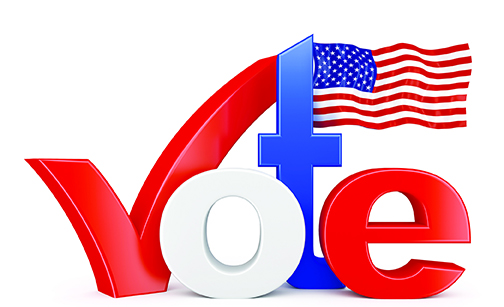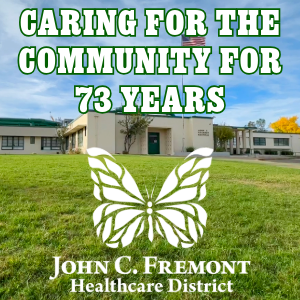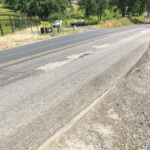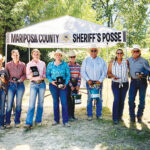
Voting data shows Mariposa County isn’t turning blue, or even purple
By R.D. Tucker
There’s been a lot of chatter recently around Mariposa County and at certain social epicenters, like the post office, that the influx of Bay Area residents and their perceived political ideologies are recoloring the county’s traditional red, or republican, posture.
Voting data contradicts that impression.
With the assistance of Mariposa County’s elections department, The Mariposan did a comparison of the voting statistics between the recent March primary election and the primary election held in June of 2012, before the state moved its primary election to the Super Tuesday spring calendar.
Although the number of registered voters has grown by 969 individuals, the percentage of electorate participation in the primary election between those two election processes is just one tenth of a percent different.
In the March primary, with 11,492 listed registered voters, 6,214 cast their vote-by-mail ballots. That equates to a participation rate of 54 percent, which is always far above the statewide participation rate. Initial data projected the statewide participation rate coming in at slightly more than 30 percent. In the June primary of 2012, 5,690 of the 10,523 registered voters exercised their right. That’s 53.9 percent participation, just a tenth of a point off the 2024 primary mark.
The split, or party preferences, of the Mariposa County electorate has only changed marginally in the 12 years between these two elections.
In the 2012 primary election, voters registered as Democrats cast 1,923 votes for their candidate, Barack Obama. That total is 33.7 percent of the aggregate ballot total. Registered Republicans cast 2,969 ballots for the presidential challenger, Mitt Romney, which is 52 percent of the aggregate ballot total. The single unknown in this primary election was the influence of the registered non-partisan voters, who cast 481 votes or 8 percent of the total.
This year’s primary election almost mirrors those results. Registered Democrats cast 1,843 ballots for their party’s candidate, with 1,698 going to incumbent President Joe Biden and totaling 29.6 percent of the total ballots cast. That’s actually a lower percentage of the aggregate total when compared to 2012.
Registered Republicans deposited 3,189 ballots for the party’s preference with Donald Trump receiving 2,256 nods and Nikki Haley collecting 350 votes. That’s 51.3 percent of the aggregate total, just 7 tenths of a percent off the mark posted in the 2012 contest.
Today, however, Independent, or non-partisan voters have a greater influence on elections, at least in Mariposa County. As of March 14 of this year, there were 11,480 registered voters, including 3,150 Democrats (27.4 percent), 5,375 Republicans (46.8 percent), and 1,917 Independent voters (16.7 percent), which also includes those registered in the American Independent Party, Green Party, Libertarian Party, and Peace and Freedom Party. The ballot totals in those party preferences totaled just 65.
The State of California no longer differentiates or identifies “non-partisan” voters. And because of political party preferences, independent voters must request a crossover ballot from the election office. That special ballot qualifies them to vote for a candidate of their choice without altering their party registration of Democrat, Republican, or Independent. The presidential election ballots are the ballots that contain party preferences in California.
“This was actually kind of a low turnout for us,” said Mariposa County Registrar of Voters, Courtney Progner-Morrow. “I think that may have been because all of the local candidates were running unopposed.” County office candidates are not identified by party preference.
Just four years ago in the March 2020 primary, which also matched Biden and Trump, the voter turnout was 66 percent. That primary happened just before the Covid 19 pandemic got rolling. That year, on March 19, the county offices and schools closed.
Although the schools remained closed under edicts from Governor Gavin Newsom, county offices opened on a limited basis later that fall.
However, not even the pandemic kept the county’s voters from casting their vote-by-mail ballots in huge numbers. In the 2020 presidential election, 10,400 voters exercised their right of the 11,121 registered voters, or 88.7 percent of the electorate.
“We switched to an all vote-by-mail system in November of 2018, so people were familiar with the process,” Progner-Morrow explained. “I’m hoping that this is a sign that people are trusting us in this process (vote-by-mail). I think vote-by-mail is a very secure process, at least here in Mariposa County,” she added.
The results county-wide were very similar in the hotly contested U.S. Senate race between Republican newcomer Steve Garvey and partisan Democrat Congressman Adam Schiff. Out of a list of 27 candidates, Garvey, a baseball legend, garnered 2,770 votes of 5,926 ballots cast. Schiff collected 1,329 votes or 22.4 percent compared to Garvey’s 46.8 percent.
Eric Early, the runner up on the Republican ticket with 368 votes, gained just six percent of the total. Democrat Katie Potter, Schiff’s only serious Democrat challenger, got 654 votes or 10.7 percent. The totals reflect the county’s electoral leaning with Republicans collecting 52.8 percent of the votes cast and the Democrats posting a combined 33.1 percent.
The consistently low voter turnout may be a reflection of the trust and attitude of the state’s electorate.
Could voters, particularly in conservative rural counties like Mariposa and thosse in the Central Valley, feel estranged in the polictal process under California’s one-party rule? Are there voters who aren’t confident in free and fair elections after the recent changes in the voting process? Do voters still believe they have a voice when legal challenges consistently overturn the expressed will of the people? All of these may reflect the attitude of the electorate, which are issues unrelated to voter aparthy, which is regularly blamed for low voter participation.
Regardless of the chatter that persists around the water cooler, voting data reveals that Mariposa County, which for decades has been a traditional Republican stronghold, isn’t drifting away from that designation. In the March primary election this year, Republicans dominated the election results in the presidential race by 21.7 percent.


















